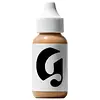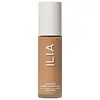What's inside
What's inside
 Key Ingredients
Key Ingredients

 Benefits
Benefits

 Concerns
Concerns

 Ingredients Side-by-side
Ingredients Side-by-side

Water
Skin ConditioningCyclopentasiloxane
EmollientCyclohexasiloxane
EmollientDimer Dilinoleyl Dimer Dilinoleate
EmollientPEG-10 Dimethicone
Skin ConditioningGlycerin
HumectantPolymethylsilsesquioxane
Alcohol
AntimicrobialDimethicone
EmollientMica
Cosmetic ColorantCaprylyl Glycol
EmollientSodium Chloride
MaskingDisteardimonium Hectorite
StabilisingChlorphenesin
AntimicrobialPropylene Carbonate
SolventBoron Nitride
AbsorbentTriethoxycaprylylsilane
Ricinus Communis Seed Oil
MaskingZea Mays Oil
EmulsifyingDiamond Powder
AbrasiveQuercus Suber Bark Extract
Skin ConditioningCI 77891
Cosmetic ColorantCI 77491
Cosmetic ColorantCI 77492
Cosmetic ColorantCI 77499
Cosmetic ColorantWater, Cyclopentasiloxane, Cyclohexasiloxane, Dimer Dilinoleyl Dimer Dilinoleate, PEG-10 Dimethicone, Glycerin, Polymethylsilsesquioxane, Alcohol, Dimethicone, Mica, Caprylyl Glycol, Sodium Chloride, Disteardimonium Hectorite, Chlorphenesin, Propylene Carbonate, Boron Nitride, Triethoxycaprylylsilane, Ricinus Communis Seed Oil, Zea Mays Oil, Diamond Powder, Quercus Suber Bark Extract, CI 77891, CI 77491, CI 77492, CI 77499
Aloe Barbadensis Leaf Juice
Skin ConditioningCoconut Alkanes
EmollientCaprylyl Methicone
Skin ConditioningPolyglyceryl-6 Polyricinoleate
EmulsifyingCetearyl Isononanoate
EmollientPolyglyceryl-2 Isostearate
EmulsifyingBoron Nitride
AbsorbentDimethicone
EmollientDisteardimonium Hectorite
StabilisingNiacinamide
SmoothingOryza Sativa Hull Powder
AbrasiveGluconolactone
Skin ConditioningSodium Chloride
MaskingIsopentyldiol
HumectantGlycerin
HumectantCoco-Caprylate/Caprate
EmollientAllantoin
Skin ConditioningSodium Benzoate
MaskingCaprylic/Capric Triglyceride
MaskingSimmondsia Chinensis Seed Oil
EmollientSclerocarya Birrea Seed Oil
HumectantSqualane
EmollientTocopherol
AntioxidantPentylene Glycol
Skin ConditioningTriethoxycaprylylsilane
Pistacia Lentiscus Gum
MaskingHydrogenated Lecithin
EmulsifyingCalcium Gluconate
HumectantEthylhexylglycerin
Skin ConditioningJasminum Officinale Flower/Leaf Extract
MaskingPhenethyl Alcohol
MaskingBisabolol
MaskingCI 77891
Cosmetic ColorantCI 77491
Cosmetic ColorantCI 77492
Cosmetic ColorantCI 77499
Cosmetic ColorantAloe Barbadensis Leaf Juice, Coconut Alkanes, Caprylyl Methicone, Polyglyceryl-6 Polyricinoleate, Cetearyl Isononanoate, Polyglyceryl-2 Isostearate, Boron Nitride, Dimethicone, Disteardimonium Hectorite, Niacinamide, Oryza Sativa Hull Powder, Gluconolactone, Sodium Chloride, Isopentyldiol, Glycerin, Coco-Caprylate/Caprate, Allantoin, Sodium Benzoate, Caprylic/Capric Triglyceride, Simmondsia Chinensis Seed Oil, Sclerocarya Birrea Seed Oil, Squalane, Tocopherol, Pentylene Glycol, Triethoxycaprylylsilane, Pistacia Lentiscus Gum, Hydrogenated Lecithin, Calcium Gluconate, Ethylhexylglycerin, Jasminum Officinale Flower/Leaf Extract, Phenethyl Alcohol, Bisabolol, CI 77891, CI 77491, CI 77492, CI 77499
 Reviews
Reviews

Ingredients Explained
These ingredients are found in both products.
Ingredients higher up in an ingredient list are typically present in a larger amount.
Boron Nitride is compound consisting of boron and nitrogen. It is used to absorb oil and modify adherence/ slip in products.
This means it is often used in makeup products to help them last longer.
Ci 77491 is also hydrated iron III oxide. It's sole purpose is to give a red/pink hue to products.
Iron III oxides are classified as inorganic chemicals for coloring.
Synthetically created Ci 77491 is considered safer than those naturally found. This is because the synthetically created version may contain less impurities. Iron oxides are generally non-toxic and non-allergenic.
Learn more about CI 77491Ci 77492 is also hydrated iron III oxide. It's sole purpose is to give a yellow hue to products.
Iron III oxides are classified as inorganic chemicals for coloring.
Synthetically created Ci 77492 is considered safer than those naturally found. This is because the synthetically created version may contain less impurities. Iron oxides are generally non-toxic and non-allergenic.
Learn more about CI 77492Ci 77499 is also hydrated iron III oxide. It is created from mixing red and black iron oxides. This helps give shades of darkness to a product.
Iron III oxides are classified as inorganic chemicals for coloring.
Ci 77891 is a white pigment from Titanium dioxide. It is naturally found in minerals such as rutile and ilmenite.
It's main function is to add a white color to cosmetics. It can also be mixed with other colors to create different shades.
Ci 77891 is commonly found in sunscreens due to its ability to block UV rays.
Learn more about CI 77891Dimethicone is a type of synthetic silicone created from natural materials such as quartz.
What it does:
Dimethicone comes in different viscosities:
Depending on the viscosity, dimethicone has different properties.
Ingredients lists don't always show which type is used, so we recommend reaching out to the brand if you have questions about the viscosity.
This ingredient is unlikely to cause irritation because it does not get absorbed into skin. However, people with silicone allergies should be careful about using this ingredient.
Note: Dimethicone may contribute to pilling. This is because it is not oil or water soluble, so pilling may occur when layered with products. When mixed with heavy oils in a formula, the outcome is also quite greasy.
Learn more about DimethiconeDisteardimonium Hectorite comes from the clay mineral named hectorite. It is used to add thickness to a product.
It can also help stabilize a product by helping to disperse other ingredients.
Hectorite is a rare, white clay mineral.
Learn more about Disteardimonium HectoriteGlycerin is already naturally found in your skin. It helps moisturize and protect your skin.
A study from 2016 found glycerin to be more effective as a humectant than AHAs and hyaluronic acid.
As a humectant, it helps the skin stay hydrated by pulling moisture to your skin. The low molecular weight of glycerin allows it to pull moisture into the deeper layers of your skin.
Hydrated skin improves your skin barrier; Your skin barrier helps protect against irritants and bacteria.
Glycerin has also been found to have antimicrobial and antiviral properties. Due to these properties, glycerin is often used in wound and burn treatments.
In cosmetics, glycerin is usually derived from plants such as soybean or palm. However, it can also be sourced from animals, such as tallow or animal fat.
This ingredient is organic, colorless, odorless, and non-toxic.
Glycerin is the name for this ingredient in American English. British English uses Glycerol/Glycerine.
Learn more about GlycerinChances are, you eat sodium chloride every day. Sodium Chloride is also known as table salt.
This ingredient has many purposes in skincare: thickener, emulsifier, and exfoliator.
You'll most likely find this ingredient in cleansers where it is used to create a gel-like texture. As an emulsifier, it also prevents ingredients from separating.
There is much debate on whether this ingredient is comedogenic. The short answer - comedogenic ratings don't tell the whole story. Learn more about comegodenic ratings here.
The concensus about this ingredient causing acne seems to be divided. Research is needed to understand if this ingredient does cause acne.
Scrubs may use salt as the primary exfoliating ingredient.
Learn more about Sodium ChlorideTriethoxycaprylylsilane is a silicone used to bind and stabilize ingredients.
As an emulsifier, it helps prevent ingredients from separating. This can help elongate the shelf life of products.
Triethoxycaprylylsilane is often used to coat mineral sunscreens ingredients to help give a better feel. It also helps reduce oxidative stress in sunscreens.
Learn more about Triethoxycaprylylsilane